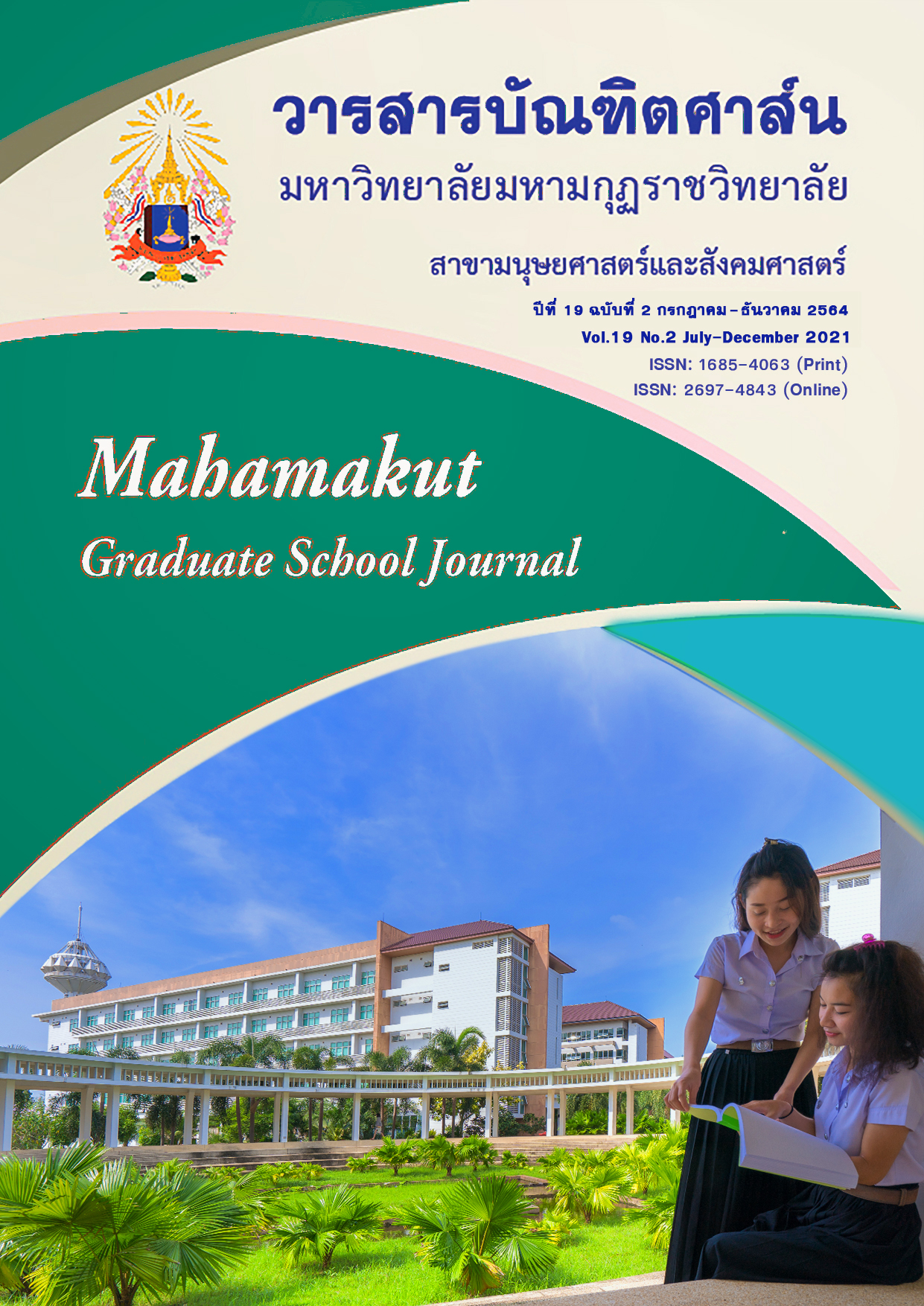ประเพณีงานศพ : การศึกษารูปแบบที่เหมาะสมทางสังคมวัฒนธรรม และเศรษฐกิจ ในการจัดพิธีกรรมของชาวพุทธ เขตราษฎร์บูรณะ กรุงเทพมหานคร
คำสำคัญ:
ประเพณีงานศพ, รูปแบบที่เหมาะสม, การจัดพิธีกรรมของชาวพุทธบทคัดย่อ
การวิจัยในครั้งนี้มีวัตถุประสงค์ดังนี้ 1) เพื่อศึกษาคติธรรมและความเป็นมาของประเพณีงานศพของชาวพุทธ 2) เพื่อศึกษาสภาพปัจจุบันประเพณีงานศพตามหลักพระพุทธศาสนาของชาวพุทธ เขตราษฎร์บูรณะ กรุงเทพมหานคร 3) เพื่อศึกษารูปแบบที่เหมาะสมในการจัดการประเพณีงานศพที่สอดคล้องกับวิถีชีวิตของชาวพุทธ เขตราษฎร์บูรณะ กรุงเทพมหานคร ใช้พื้นที่ภาคกลางของประเทศไทยเป็นพื้นที่การศึกษา โดยผู้วิจัยเลือกพื้นที่กรุงเทพมหานคร เป็นพื้นที่วิจัย และเจาะจงเลือกพื้นวัดในเขตราษฎร์บูรณะที่มีอยู่ทั้งหมด 7 วัด กลุ่มผู้ให้ข้อมูล ได้แก่ กลุ่มผู้รู้ กลุ่มผู้ปฏิบัติ และกลุ่มให้ข้อมูลทั่วไป จำนวน 70 คน เครื่องมือที่ใช้ในการวิจัย ได้แก่ แบบสำรวจ แบบสังเกต แบบสัมภาษณ์ แบบการสนทนากลุ่ม และแบบการประชุมเชิงปฏิบัติการ ทำการเก็บรวบรวมข้อมูลทั้งภาคเอกสารและภาคสนาม โดยใช้รูปแบบวิจัยเชิงคุณภาพทางวัฒนธรรม นำข้อมูลที่ได้มาตรวจสอบความถูกต้องแล้ววิเคราะห์ข้อมูลตามวัตถุประสงค์ที่ตั้งไว้แล้วนำเสนอผลการวิจัยด้วยวิธีพรรณนาวิเคราะห์
ผลการวิจัยพบว่า 1) ประเพณีงานศพ ได้สะท้อนคุณค่าของชีวิต และได้รับคติธรรมดังนี้ 1) ประเพณีการปฏิบัติต่อคนป่วยใกล้ตาย ได้รับคติธรรม คือ การมีสติก่อนตาย ความไม่ประมาท และการเห็นสัจธรรมของชีวิต 2) ประเพณีการปฏิบัติต่อศพ ได้รับคติธรรม คือ ความกตัญญูกตเวที และการเข้าใจหลักไตรลักษณ์ 3) ประเพณีการสวดศพ ได้รับคติธรรม คือ การอุทิศส่วนกุศลแก่คนตาย และการมีน้ำใจ 4) ประเพณีการบวชหน้าศพและจูงศพ ได้รับคติธรรม คือ ความกตัญญูกตเวที 5) ประเพณีการเผาศพ ได้รับคติธรรม คือ การเห็นสัจธรรมของชีวิต และความไม่ประมาท 6) ประเพณีการเก็บอัฐิ ให้คติธรรม คือ ความกตัญญูกตเวที และความเชื่อเรื่องการเกิดใหม่ 2) พิธีกรรม ความเชื่อ และขั้นตอนการประกอบพิธีกรรมงานศพ ประกอบด้วยพิธีกรรมดังนี้ คือ การรดน้ำศพ การมัดตราสัง การสวดพระอภิธรรม การเซ่นศพ การบำเพ็ญกุศล การเวียนเมรุ การล้างหน้าศพ การเผาศพ การแปรรูป การเก็บอัฐิ และการฉลองอัฐิ แต่ในปัจจุบันนี้ พิธีกรรมบางอย่างไม่มีการประกอบพิธีที่วัดแล้ว เช่น การอาบน้ำศพ และการแต่งตัวศพ เพราะส่วนใหญ่ผู้เสียชีวิตที่โรงพยาบาล มักจะมีการทำพิธีดังกล่าวนี้ที่โรงพยาบาลก่อนที่จะนำศพผู้เสียชีวิตมาประกอบพิธีกรรมทางศาสนาที่วัด 3) มีการจัดพิธีศพที่ทำให้เกิดผลกระทบต่อวิถีชีวิตของคนในชุมชน เช่น เมื่อจัดงานศพเสร็จแล้วมีภาระหนี้สินที่เกิดจากการจัดงานที่ไม่เหมาะสม เพราะไม่รู้ไม่เข้าใจประเพณีพิธีกรรมที่ถูกต้องเหมาะสมดีงามตามหลักการทางพระพุทธศาสนาและจารีตประเพณีนิยมของชุมชน จึงจำเป็นต้องมีการปรึกษาหารือร่วมกันระหว่างผู้นำในชุมชน คือ พระสงฆ์ มรรคนายก และประชาชนในชุมชน เพื่อหาแนวทางในการจัดงานศพร่วมกัน จะได้เกิดความเรียบร้อยเหมาะสมและความถูกต้องดีงามตามหลักการทางพระพุทธศาสนาและสอดคล้องกับประเพณีนิยม ควรมีหลักการหรือข้อตกลงร่วมกันในการจัดงานศพ เช่น ห้ามเลี้ยงสุรา และห้ามเล่นการพนัน ซึ่งทุกคนในชุมชนต้องปฏิบัติอย่างเคร่งครัด และต้องสร้างให้เป็นมาตรฐานที่ยอมรับในชุมชน และถือข้อปฏิบัติหรือข้อตกลงร่วมกัน อันเป็นการปฏิบัติตามนโยบายทางราชการและพระราชบัญญัติการพนัน
เอกสารอ้างอิง
เสฐียรโกเศศ. (2531). การตาย ประเพณีเกี่ยวกับชีวิต. กรุงเทพฯ: โรงพิมพ์ภาพพิมพ์.
สมปราชญ์ อัมมะพันธ์. (2536). ประเพณีและพิธีกรรมในวรรณคดี. กรุงเทพฯ: โอ. เอส. พริ้นติ้ง เฮ้า.
ธวัช ปุณโณทก, 2526: วัฒนธรรมพื้นบ้าน คติความเชื่อในวัฒนธรรมความเชื่อ : คติความเชื่อ.กรุงเทพฯ โรงพิมพ์จุฬาลงกรณ์มหาวิทยาลัย.
พระยาอนุมานราชธน, 2531: วัฒนธรรม. กรุงเทพฯ, โรงพิมพ์จุฬาลงกรณ์มหาวิทยาลัย.
มหาจุฬาลงกรณราชวิทยาลัย. (2506). พระไตรปิฎก ภาษาบาลี ฉบับมหาจุฬาเตปิฎกํ 2500.กรุงเทพฯ: โรงพิมพ์รุ่งเรืองธรรม.
พระเทพวิสุทธิเมธี, 2536: มรณานุสติ. กรุงเทพฯ . โรงพิมพ์ธรรมสภา.
ธัชพล ศิริวงศ์ทอง. (2542). ตายแล้วไปไหน. เชียงใหม่: ดาวการพิมพ์.
มหาจุฬาลงกรณราชวิทยาลัย. 2539. อรรถกถาภาษาบาลี. กรุงเทพฯ : โรงพิมพ์มหาจุฬาลงกรณราชวิทยาลัย.
สายทิพย์ นุกูลกิจ, 2533: วรรณกรรมไทยปัจจุบัน. กรุงเทพฯ : การพิมพ์พระนคร
ภารดี มหาขันธ์, 2532: พื้นฐานอารยธรรมไทย กรุงเทพฯ : โอเดียนสโตร์
เสฐียรโกเศศ. (2531). การตาย ประเพณีเกี่ยวกับชีวิต. กรุงเทพฯ: โรงพิมพ์ภาพพิมพ์.
รัชนีกร เศรษโฐ, 2533: โครงสร้างสังคมและวัฒนธรรมไทย. กรุงเทพฯ : ไทยวัฒนาพานิช.
วิชาภรณ์ แสงมณี และประเสริฐ ลีวานันท์, 2535: ประเพณีและกฎหมาย. กรุงเทพฯ : เดือนสยาม
สายทิพย์ นุกูลกิจ, 2533: วรรณกรรมไทยปัจจุบัน. กรุงเทพฯ : การพิมพ์พระนคร
ปราณี วงษ์เทศ. 2534. พิธีกรรมเกี่ยวกับการตายในประเทศไทย. กรุงเทพฯ: อมรินทร์พริ้นติ้งกรุ๊ป.
บริษัทศูนย์วิจัยกสิกรไทย, 2538
ดาวน์โหลด
เผยแพร่แล้ว
รูปแบบการอ้างอิง
ฉบับ
ประเภทบทความ
สัญญาอนุญาต
ลิขสิทธิ์ (c) 2021 มหาวิทยาลัยมหามกุฏราชวิทยาลัย

อนุญาตภายใต้เงื่อนไข Creative Commons Attribution-NonCommercial-NoDerivatives 4.0 International License.
บทความวิชาการและบทความวิจัยในวารสารฉบับนี้ถือเป็นความรับผิดชอบของผู้เขียนเท่านั้น บทความที่ได้รับการตีพิมพ์ในวารสารบัณฑิตศาส์น ถือเป็นลิขสิทธิ์ของมหาวิทยาลัยมหามกุฏราชวิทยาลัย ตามพระราชบัญญัติลิขสิทธิ์



